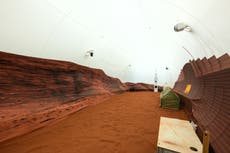Scientists find evidence of ‘very recent’ running water flowing on Mars
‘Mars has been able to create liquid water in enough volume to erode channels’
Gullies on the slopes of Martian craters were likely created by the “very recent” flow of water, according to a new study that sheds more light on whether life could exist on the Red Planet.
The presence of life on a planet, as it is seen on Earth, goes hand in hand with the existence of liquid water.
Researchers have previously shown that there may have been past periods on Mars when liquid water likely formed gullies if Mars tilted enough on its axis.
The new study, published in the journal Science on Thursday, estimated this tilt angle and matched it with the locations and altitudes of gullies that have so far been discovered on the Red Planet.
Researchers, including Jim Head from Brown University in the US, simulated the conditions on Mars that would have allowed the planet to warm above freezing temperatures, leading to periods of liquid water when ice on and beneath the surface melts.
“We know from a lot of our research and other people’s research that early on in Mars’s history, there was running water on the surface with valley networks and lakes,” Dr Head said.
“But about 3 billion years ago, all of that liquid water was lost, and Mars became what we call a hyper-arid or polar desert. We show here that even after that and in the recent past, when Mars’s axis tilts to 35 degrees, it heats up sufficiently to melt snow and ice, bringing liquid water back until temperatures drop and it freezes again,” he explained.
These findings reveal the missing gaps in how Martian gullies form, including how high they start, how severe the erosion is, and how far they extend down the side of craters.
Scientists found that gully formation on Mars was driven by periods of melting ice and by carbon dioxide frost evaporation in other parts of the year.
They say this process may have occurred repeatedly over the past several million years with the most recent occurrence likely about 630,000 years ago.
The simulations suggest that if ice was present at these gully locations when Mars’ axis tilted to about 35 degrees, the conditions would have been just right for the ice to melt.
This is because, in these conditions, temperatures in these gullies would have risen above 273 degrees Kelvin, equivalent to about 32 degrees Fahrenheit.
“Our study shows that the global distribution of gullies is better explained by liquid water over the last million years,” Jay Dickson, another author of the study, said.
“Water explains the elevation distribution of gullies in ways that CO2 cannot. This means that Mars has been able to create liquid water in enough volume to erode channels within the last million years, which is very recent on the scale of Mars’s geologic history,” Dr Dickson added.
The new findings highlight gullies as potential targets to visit during future exploration missions on Mars to look for signs of life.
“Any microorganism that might have evolved in early Mars is going to be in places where they can be comfortable in ice and then also comfortable or prosperous in liquid water. In the frigid Antarctic environment, for example, the few organisms that exist often occur in stasis, waiting for water,” Dr Head said.
Join our commenting forum
Join thought-provoking conversations, follow other Independent readers and see their replies
Comments


Bookmark popover
Removed from bookmarks